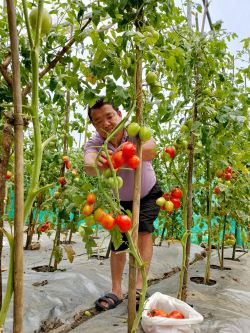In the high-rainfall zones of the Sikkim Himalaya receiving nearly 3,500 mm of annual rainfall excess moisture often limits the growth and productivity of high-value vegetable crops such as tomato. To overcome this challenge and ensure a steady supply of tomatoes during the summer months, when local availability is scarce, off-season tomato cultivation under protected structures has emerged as a highly promising intervention. In Dzongu, North Sikkim, polyhouse-grown tomatoes fetch premium market prices (₹80/kg) during the rainy season, compared to ₹60/kg for open-field tomatoes harvested in winter, creating an attractive income opportunity for tribal farmers supplying nearby markets like Mangan and Dikchu.
Recognizing this potential, the ICAR–NEH Sikkim Centre introduced off-season organic tomato cultivation among the tribal Lepcha farmers of Lower Dzongu under the Tribal Sub Plan (TSP). Through technology demonstrations, a total of 114 farmers benefitted from this initiative. Two tomato cultivars indeterminate ‘Romeo’ and semi-determinate ‘Arka Rakshak’ were sown in mid-April and grown under complete organic nutrient and pest management protocols. Hand pollination was carried out by gently shaking plants at flowering, while fruit harvesting began in late June and continued until mid-November, with picking intervals of 4–6 days to minimize postharvest losses.

Among the beneficiaries, Mr. Norbu Tshering Lepcha of Hee-Gyathang village emerged as a standout example of successful greenhouse-based organic tomato cultivation. Since 2021, he has been cultivating 200 tomato plants over 180 m² under protected conditions, intercropping summer tomato with vegetable mustard for additional green-leaf harvest. His organic management included the application of vermicompost (@ ~5 kg/m²) during land preparation and periodic foliar sprays of IFFCO Sagarika seaweed extract (~3 ml/litre) to boost crop vigor.
To maintain plant health, he systematically removed lower foliage after flowering and trained the plants by twirling vines around strings at 30 cm height, ensuring good aeration and keeping fruits off the soil. Under this protected organic system, his summer tomato yield reached 6–8 kg per plant, significantly higher than the 4–5 kg per plant typically achieved under open-field winter cultivation. Overall, Mr. Lepcha harvested 180–210 kg of tomatoes from his polyhouse, compared to 90–100 kg during winter from an equivalent area.
To manage pest and disease pressure, he adopted a sustainable crop rotation strategy, growing bottle gourd (‘Kashi Bahar’) on elevated bamboo trellises inside the polyhouse in alternate years an approach that helped maintain soil health and supported long-term organic production.

The visible success achieved by Mr. N. T. Lepcha in terms of improved yields, assured market demand, and enhanced income gradually inspired farmers across neighboring TSP villages. Encouraged by his demonstrated results, many farmers have now begun replicating and scaling up protected organic tomato cultivation. This growing adoption reflects a transformative shift toward sustainable, profitable, and climate-resilient farming systems in the tribal regions of Sikkim.
The initiative stands as a compelling example of how scientific intervention, combined with traditional wisdom and farmer-driven innovation, can create meaningful livelihood opportunities and strengthen socio-economic well-being among tribal communities in the Eastern Himalayas.
(Source: ICAR Research Complex for NEH Region, Sikkim Center, Tadong, Department of Horticulture, Govt. of Sikkim)








Like on Facebook
Subscribe on Youtube
Follow on X X
Like on instagram